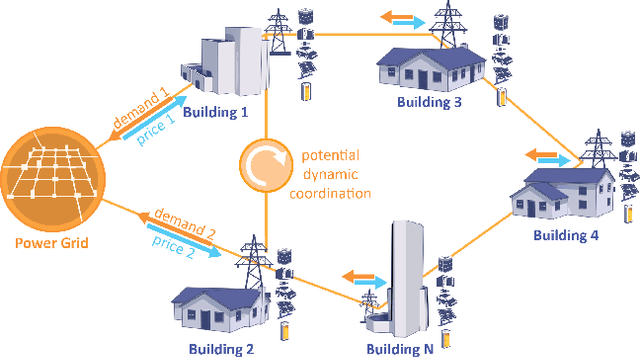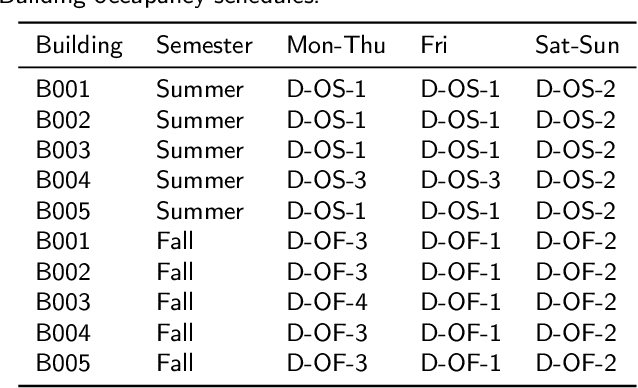Kingsley Nweye
CityLearn v2: Energy-flexible, resilient, occupant-centric, and carbon-aware management of grid-interactive communities
May 02, 2024Abstract:As more distributed energy resources become part of the demand-side infrastructure, it is important to quantify the energy flexibility they provide on a community scale, particularly to understand the impact of geographic, climatic, and occupant behavioral differences on their effectiveness, as well as identify the best control strategies to accelerate their real-world adoption. CityLearn provides an environment for benchmarking simple and advanced distributed energy resource control algorithms including rule-based, model-predictive, and reinforcement learning control. CityLearn v2 presented here extends CityLearn v1 by providing a simulation environment that leverages the End-Use Load Profiles for the U.S. Building Stock dataset to create virtual grid-interactive communities for resilient, multi-agent distributed energy resources and objective control with dynamic occupant feedback. This work details the v2 environment design and provides application examples that utilize reinforcement learning to manage battery energy storage system charging/discharging cycles, vehicle-to-grid control, and thermal comfort during heat pump power modulation.
MERLIN: Multi-agent offline and transfer learning for occupant-centric energy flexible operation of grid-interactive communities using smart meter data and CityLearn
Dec 31, 2022



Abstract:The decarbonization of buildings presents new challenges for the reliability of the electrical grid as a result of the intermittency of renewable energy sources and increase in grid load brought about by end-use electrification. To restore reliability, grid-interactive efficient buildings can provide flexibility services to the grid through demand response. Residential demand response programs are hindered by the need for manual intervention by customers. To maximize the energy flexibility potential of residential buildings, an advanced control architecture is needed. Reinforcement learning is well-suited for the control of flexible resources as it is able to adapt to unique building characteristics compared to expert systems. Yet, factors hindering the adoption of RL in real-world applications include its large data requirements for training, control security and generalizability. Here we address these challenges by proposing the MERLIN framework and using a digital twin of a real-world 17-building grid-interactive residential community in CityLearn. We show that 1) independent RL-controllers for batteries improve building and district level KPIs compared to a reference RBC by tailoring their policies to individual buildings, 2) despite unique occupant behaviours, transferring the RL policy of any one of the buildings to other buildings provides comparable performance while reducing the cost of training, 3) training RL-controllers on limited temporal data that does not capture full seasonality in occupant behaviour has little effect on performance. Although, the zero-net-energy (ZNE) condition of the buildings could be maintained or worsened as a result of controlled batteries, KPIs that are typically improved by ZNE condition (electricity price and carbon emissions) are further improved when the batteries are managed by an advanced controller.
Real-world challenges for reinforcement learning in building control
Nov 25, 2021



Abstract:Building upon prior research that highlighted the need for standardizing environments for building control research, and inspired by recently introduced benchmarks for real life reinforcement learning control, here we propose a non-exhaustive nine real world challenges for reinforcement learning building controller. We argue that building control research should be expressed in this framework in addition to providing a standardized environment for repeatability. Advanced controllers such as model predictive control and reinforcement learning control have both advantages and disadvantages that prevent them from being implemented in real world buildings. Comparisons between the two are seldom, and often biased. By focusing on the benchmark problems and challenges, we can investigate the performance of the controllers under a variety of situations and generate a fair comparison. Lastly, we call for a more interdisciplinary effort of the research community to address the real world challenges, and unlock the potentials of advanced building controllers.
MARTINI: Smart Meter Driven Estimation of HVAC Schedules and Energy Savings Based on WiFi Sensing and Clustering
Oct 17, 2021



Abstract:HVAC systems account for a significant portion of building energy use. Nighttime setback scheduling is an energy conservation measure where cooling and heating setpoints are increased and decreased respectively during unoccupied periods with the goal of obtaining energy savings. However, knowledge of a building's real occupancy is required to maximize the success of this measure. In addition, there is the need for a scalable way to estimate energy savings potential from energy conservation measures that is not limited by building specific parameters and experimental or simulation modeling investments. Here, we propose MARTINI, a sMARt meTer drIveN estImation of occupant-derived HVAC schedules and energy savings that leverages the ubiquity of energy smart meters and WiFi infrastructure in commercial buildings. We estimate the schedules by clustering WiFi-derived occupancy profiles and, energy savings by shifting ramp-up and setback times observed in typical/measured load profiles obtained by clustering smart meter energy profiles. Our case-study results with five buildings over seven months show an average of 8.1%-10.8% (summer) and 0.2%-5.9% (fall) chilled water energy savings when HVAC system operation is aligned with occupancy. We validate our method with results from building energy performance simulation (BEPS) and find that estimated average savings of MARTINI are within 0.9%-2.4% of the BEPS predictions. In the absence of occupancy information, we can still estimate potential savings from increasing ramp-up time and decreasing setback start time. In 51 academic buildings, we find savings potentials between 1%-5%.
 Add to Chrome
Add to Chrome Add to Firefox
Add to Firefox Add to Edge
Add to Edge